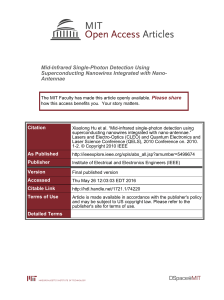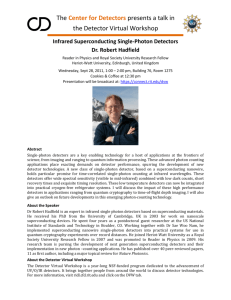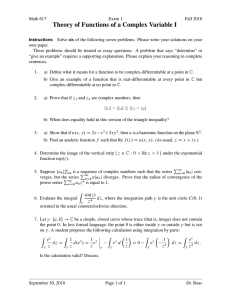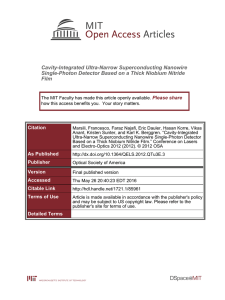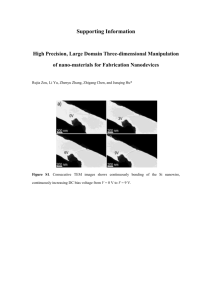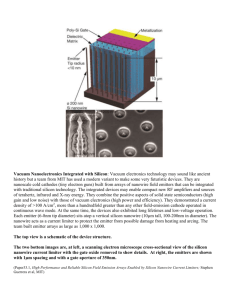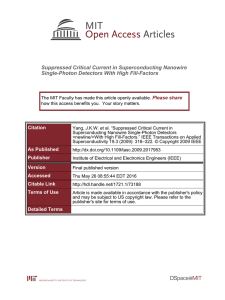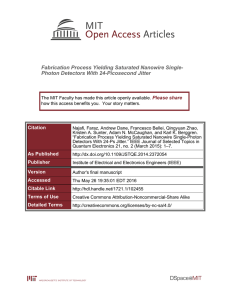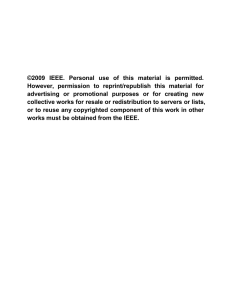Using surface plasmons to enhance the speed and detectors
advertisement
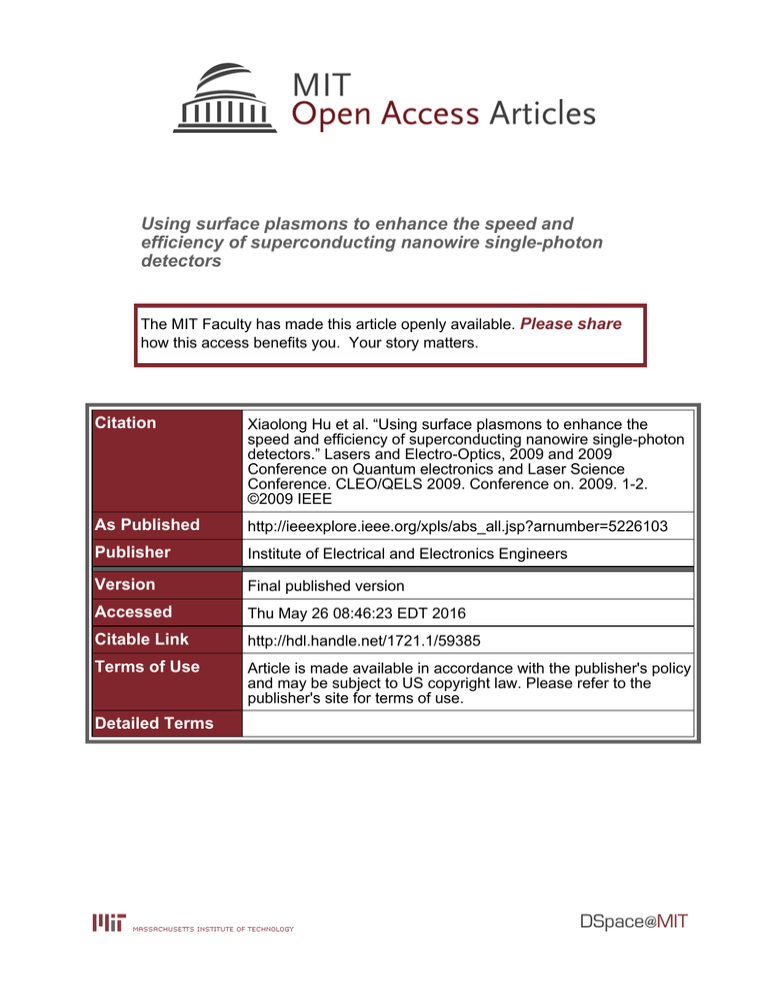
Using surface plasmons to enhance the speed and efficiency of superconducting nanowire single-photon detectors The MIT Faculty has made this article openly available. Please share how this access benefits you. Your story matters. Citation Xiaolong Hu et al. “Using surface plasmons to enhance the speed and efficiency of superconducting nanowire single-photon detectors.” Lasers and Electro-Optics, 2009 and 2009 Conference on Quantum electronics and Laser Science Conference. CLEO/QELS 2009. Conference on. 2009. 1-2. ©2009 IEEE As Published http://ieeexplore.ieee.org/xpls/abs_all.jsp?arnumber=5226103 Publisher Institute of Electrical and Electronics Engineers Version Final published version Accessed Thu May 26 08:46:23 EDT 2016 Citable Link http://hdl.handle.net/1721.1/59385 Terms of Use Article is made available in accordance with the publisher's policy and may be subject to US copyright law. Please refer to the publisher's site for terms of use. Detailed Terms a1458_1.pdf ITuM2.pdf ITuM2.pdf © 2009 OSA/CLEO/IQEC 2009 Using Surface Plasmons to Enhance the Speed and Efficiency of Superconducting Nanowire Single-Photon Detectors 1 Xiaolong Hu,1* Eric A. Dauler, 1, 2 Andrew J. Kerman, 2 Joel K. W. Yang, 1 James E. White, 1 Charles H. Herder, 1 and Karl K. Berggren 1* Research Laboratory of Electronics,, Massachusetts Institute of Technology,77 Massachusetts Avenue, Cambridge, MA 02139, USA 2 Lincoln Laboratory, Massachusetts Institute of Technology, 244 Wood St., Lexington, Massachusetts 02420, USA *Corresponding author: xlhu@mit.edu, berggren@mit.edu Abstract: We report our design and fabrication of superconducting nanowire single-photon detectors integrated with gold plasmonic nanostructures, which can enhance the absorption of TM-polarized light, and can enlarge the effective area without sacrificing detector speed. ©2009 Optical Society of America OCIS codes: 040.5160, 050.6624. Niobium nitride (NbN) superconducting nanowire single-photon detectors (SNSPDs) are an emerging, ultrasensitive photon counting technology which outperforms others at infrared wavelengths. Applications such as fiber-based quantum key distribution [1] have already been demonstrated. However, some other applications such as linear optical quantum computing require efficiency approaching 100%. Furthermore, there is inevitably a trade-off between coupling efficiency and the speed of the detector: coupling light into the detector requires a long meander to cover a large area, which will slow down the detector because its speed is limited by the kinetic inductance of the nanowire, proportional to the nanowire length. A multi-element approach [2] can solve this problem, but requires more complicated readout electronics. Thus, it is desirable to realize more efficient and faster single-element SNSPDs. To make each individual detector more efficient and faster, we integrated SNSPDs with subwavelength gold gratings and cavities. The advantages of adding these gold plasmonic nanostructures are two-fold: firstly, the absorption of transverse-magnetic (TM)-polarized light can be enhanced to 96% according to our finite-element simulation; secondly, the effective area can be enlarged to facilitate its coupling with other optical systems without increasing the nanowire length. Therefore, the coupling-speed tradeoff can be reduced on the single-element level. (d) Fig. 1. A superconducting nanowire single-photon detector integrated with a gold grating and reflector: (a) device cross section (not to scale); (b) absorptance for TM-polarization as a function of cavity length, lc (solid line, p = 200 nm), also compared with the detectors only integrated with a cavity (dashed line, p = 200 nm) or a grating (dash-dotted line, p = 200 nm); (c) the electrical field magnitude distribution (surface, with arbitrary units) and optical power flow (arrow) near the NbN nanowire, and note that the figure is not to scale; (d) absorptance for TM-polarization as a function of the pitch, p, by varying the width of the gold between adjacent NbN nanowires. The device structure is schematically shown in Fig. 1 (a). Compared with the detector that our group demonstrated in the past [3], the key element added here is a gold sub-wavelength grating between adjacent NbN nanowires. This gold grating essentially behaves as a set of optical antennae because it can effectively collect TMpolarized incident photons as we will show below. For fabrication considerations, the gold grating layer is designed to connect with the gold reflector. On top of the NbN there is a 2-nm-thick layer of NbNOx (not shown). The cavity length lc is defined as the distance between the top surface of NbNOx and the bottom surface of the reflector. Inside the cavity is hydrogen silsesquioxane (HSQ), commonly used as a resist for electron-beam lithography. The gap between the gold grating and the adjacent NbN is noted as g. We performed finite-element optical simulation on this structure. The detector is illuminated from the bottom thorough the substrate, and the wavelength used throughout this paper is 1550 nm. For TM-polarization, the 978-1-55752-869-8/09/$25.00 ©2009 IEEE 1 a1458_1.pdf ITuM2.pdf ITuM2.pdf © 2009 OSA/CLEO/IQEC 2009 absorptance peaks at lc = 220 nm and the corresponding absorptance is 0.96 as shown in Fig. 1 (b). The absorptance of NbN with the cavity only and with the gold grating only was also obtained by simulation, shown as the dashed line and the dash-dotted line in Fig. 1(b), respectively. As a comparison, the largest absorptance with cavity only is ~70% when the light is TE-polarized. The ability of the grating to collect the TM-polarized photons onto the NbN is shown in Fig. 1(c) by plotting the optical power flow (arrows): the photons are concentrated in the slot between the gold where the NbN is located. Essentially the gold grating acts as an array of metal-insulator-metal surface-plasmon waveguides, and such waveguides support modes with TM-polarization. The effective active area of the detector can be enlarged by increasing the width of the gold structure without increasing the length of the NbN nanowire. Shown in Fig. 1(d), as the pitch increases from 200 nm to 400 nm by increasing the width of the gold grating between the NbN nanowires from 100 nm to 300 nm, while keeping other parameters unchanged, the absorptance is gradually reduced to 0.73. With sacrificing some absorptance, the total area of the detector is doubled, which makes coupling easier, which can increase the coupling efficiency. We fabricated the detectors with an integrated gold grating and cavity. The process is simple and straightforward: the major difference with the process we used in the past [3] is that here, we used undiluted FOx-14 to yield much thicker resist about 230 nm. We demonstrated that direct e-beam writing on such thick HSQ with appropriate doses can yield uniform nanowire meander structure. After 100 second reactive ion etching with tetrafluoromethane, the rest thickness of HSQ was measured to be 200 nm. We spun ~1 μm S1813 photoresist and opened a window aligned with the devices. We evaporated 10 nm silicon oxide followed by 3 nm titanium and 330 nm gold, and did lift-off in N-Methyl-2-pyrrolidone at 90 °C. After liftoff, the devices with 100 nm wide NbN nanowire on 300 nm pitch are shown in Fig. 2 with the gold grating and cavity structure. Fig. 2. Scanning electron microscopic images of a detector with integrated gold grating and cavity. The detector is 9-μm-by-9-μm in area, with 100-nm wide NbN nanowire meander and a pitch of 300 nm, and coated with 10-nm silicon oxide, 3-nm titanium and 330-nm gold. In summary, we have designed and fabricated superconducting nanowire single-photon detectors integrated with gold gratings and cavities. According to our design, the absorption of TM-polarized incident light can be greatly enhanced, and the effective area of the detector can be enlarged without increasing the length of the nanowire. We believe that these detectors can work simultaneously with high system detection efficiency and high speed. This work is sponsored by the United States Air Force under Contract #FA8721-05-C-0002. Opinions, interpretations, recommendations and conclusions are those of the authors and are not necessarily endorsed by the United States Government. The work at MIT campus was also supported by IARPA. References [1] Hiroki Takesue, Sae Woo Nam, Qiang Zhang, Robert H. Hadfield, Toshimori Honjo, Kiyoshi Tamaki, and Yoshihisa Yamamoto, “Quantum key distribution over a 40-dB channel loss using superconducting single-photon detectors”, Nature Photonics 1, 343 - 348 (2007). [2] Eric A. Dauler, Bryan S. Robinson, Andrew J. Kerman, Joel K. W. Yang, Kristine M. Rosfjord, Vikas Anant, Boris Voronov, Gregory Gol'tsman, and Karl K. Berggren , “Multi-Element Superconducting Nanowire Single-Photon Detector,”, IEEE Transactions on Applied Superconductivity, 17 279-284 (2007). [3] K. M. Rosfjord, J. K. W. Yang, E. A. Dauler, A. J. Kerman, V. Anant, B. M. Voronov, G. N. Gol'tsman, and K. K. Berggren, “Nanowire single-photon detector with an integrated optical cavity and anti-reflection coating”, Opt. Express 14, 527 (2006). 2
